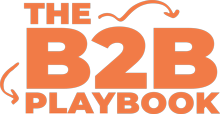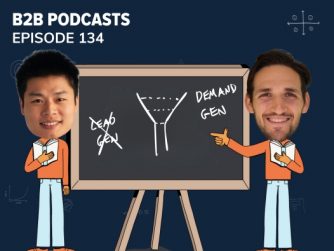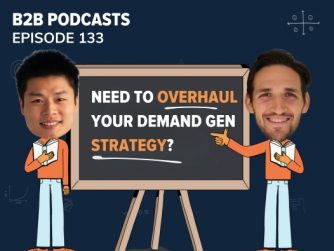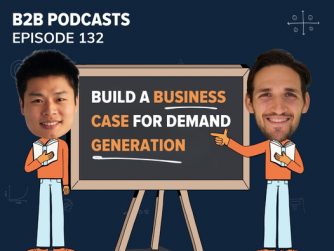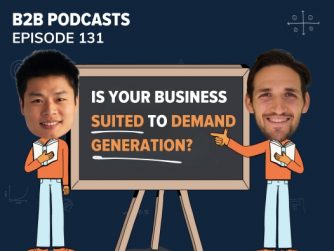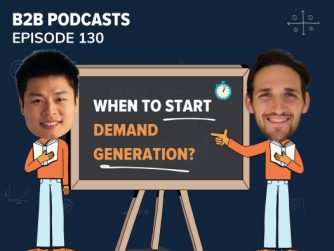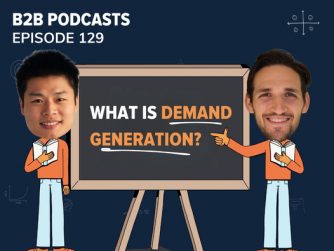A strong demand generation marketing strategy is essential in any business (especially B2B) if it wants to scale sustainably. Unfortunately, there is a lot of confusion about what demand generation even is, and not a lot of guidance on how to consistently execute the strategy in your business until it starts to drive revenue for you.
We’ll walk you through exactly what demand generation is, and introduce you to a demand gen framework that’s been rigorously tested and is helping B2B marketers drive pipeline and revenue all over the world.
It’s called our 5 BEs Framework for demand generation marketing, and you can watch, listen or read about it and how to implement it in your business below.
Listen To The Episode
Watch The Episode
What Is Demand Generation?
Demand generation is a go-to-market strategy that builds an intense desire in your Dream Customers to purchase from you.
It’s often confused with lead generation and brand marketing. A holistic demand generation strategy should work across the entire buyer journey – both capturing demand of those who are ready to buy right now, and creating demand for those who aren’t in market yet, but will be one day.
Demand Creation vs Demand Capture
Demand generation consists of two key parts: demand capture and demand creation.
Research shows that of your total market, only about 3% are in ‘buy mode’, actively looking for a solution like yours right now. Demand capture is about targeting this 3% of people in your market who are ready to buy right now, and turning them into paying customers as efficiently as possible.
A holistic demand generation strategy should work across the entire buyer journey – both capturing demand of those who are ready to buy right now, and creating demand for those who aren’t in market yet, but will be one day.
Creating demand looks to the other 97% of the market who isn’t in ‘buy’ mode right now. You want to build a relationship with them and create an intense desire for them to purchase from your brand. They’re often unaware or problem aware, so it becomes your job to make them feel the pain of the problem they have that your product solves.
Our favourite framework for understanding each of these and where they operate in the buying journey is to look at The 5 Stages of Awareness.

The 5 Stages of Awareness is a great framework to understand the journey someone goes from being unaware that they even have a problem, to being led to the logical conclusion you’re the perfect the fit for them.
Creating demand is about targeting those that are much earlier in their buying journey (unaware, problem aware), and building trust and relationships in a way that also makes them realise they need you and that you’re the perfect fit for them.
Capturing and accelerating demand is targeting those that are further in the buying journey that are actively looking to solve a problem that you help with right now.
Why Demand Capture Alone Does Not Scale
The problem with only capturing demand is that it does not scale profitably. Research shows that only 3% of your market are available to capture. This means that as your organisation grows and tries to capture more of that 3%, so are your competitors.
Lay on another statistic from Bain & Co. that of the 3% in market, only 20% will consider purchasing from you if they haven’t heard of you before starting their search for a vendor.
It’s like jumping into a pool of sharks competing for the same number of fish. The cost to compete becomes too great – with often the blame being laid on the shoulders of the performance marketer.
Lay on another statistic from Bain & Co. that of the 3% in market, only 20% will consider purchasing from you if they haven’t heard of you before starting their search for a vendor. That means just 20% of 3% of the market is available to you – which works out to be 0.6%.
So without demand creation, only 0.6% of the market is available to you.
That’s why sometimes it can feel like finding a needle in a haystack!
Our 5 BEs Framework for Demand Generation
Kevin and I have shared our 5 BEs framework for Demand Generation marketing step-by-step on The B2B Playbook across 120+ episodes. After feeling frustrated ourselves at the lack of information around a holistic demand generation program, we decided to give our Framework away (once we had one that worked!) to those who wanted to listen.
The 5 stages of the 5 BEs Framework for Demand Generation are:
- Be Ready – Deeply Understand Your Customers
- BE Helpful – Develop Relationships with your ICP with Helpful Content
- BE Seen – Accelerate Demand with Paid Media and ABM
- BE Better – Optimise your Workflow
- BE The Best – Advanced Demand Gen Tactics
B2B marketers that have worked through these steps have turned their marketing functions around and in some cases are now helping to drive 80% of pipeline for their team.
Let’s go through each of these in more detail.
Stage 1 – BE Ready – Deeply Understand Your Customers
The goal of B2B marketing is to establish trust between our Dream customers and our brand, and lead them to the logical conclusion that we’re the perfect solution to the problem they’re having.
We recommend you start with 80/20 analysis to identify who your Ideal Customers are (ICP), so you can focus your attention and limited resources on a segment of the market.
If we’re going to do that, we need to first define WHO are best customers are, and then do the hard work to deeply understand them.
That’s why we recommend you start with 80/20 analysis to identify who your Ideal Customers are (ICP), so you can focus your attention and limited resources on a segment of the market. Once you have done that, you will need to deeply understand this segment, and run customer interviews to find out information like:
- What the buying committee looks like
- What great pains do you help solve for the customer
- Why are you such a great fit for them
- What does their buying journey look like
- Where do they hang out online and offline
- What sources of information do they trust
This then provides you with the information you need to update your positioning, messaging, and a roadmap for where you need to be to reach your Dream Customers, and what you need to say to them to build their trust.
The complete list of steps in stage 1 are:
- Conduct 80/20 analysis
- Interview Dream Customers
- Document Ideal Customer Profiles (ICP)
- Update your Positioning and Messaging
- Map the Buying Journey
- Create your Dream 100 sources of influence
We have episodes detailing each of these steps and have created resources to support them too.
Stage 2 – BE Helpful – Develop Relationships with Helpful Content
Once we have a deep understanding of our Dream Customers, we need to develop relationships with them to earn their trust, and also gently lead them along the buying journey. This is very important in the demand creation process.
That’s where creating content that is closely aligned with The 5 Stages of Awareness framework is incredibly useful to help to do this.
Key to this content creation process is ensuring that there is a Subject Matter Expert involved in its creation. For example, if you are selling a solution to engineers, chances are your freelancer ‘faking’ expertise won’t go very far to impressing the engineers you’re selling to – they can sniff it out a mile away. The marketer’s role here is to help extract key insights from their Subject Matter Experts (either internal or external to the business), and to get their helpful information in front of their Dream Customers.

What’s important is doing this in a time and resource effective way, as Subject Matter Experts have other jobs they have to do other than help you with marketing!
The complete list of steps in stage 2 are:
- Understand how to help your ICP
- Create helpful content that educates and entertains
- Use Subject Matter Experts to create pillar content with on a regular schedule
- Repurpose this content to multiple channels for ease of consumption for your ICP
- Distribute your helpful content wherever it is your ICP is present
- Scale your content production
- Improve with quantitative and qualitative data
Many companies fail to execute this stage properly because they don’t know how to measure the leading and lagging indicators of success for this demand generation program.
We detail here the demand generation metrics you should measure so you can see if what you’re doing is working.
Stage 3 – BE Seen – Accelerate Demand with Paid Media & ABM
Once you’ve done the hard work in stages 1 and 2, stage 3 becomes a LOT easier. Stage 3 (BE Seen) is about accelerating the demand you’re creating in steps 1 and 2.
One of the best ways you can accelerate this process is using paid media. Paid media can be used to amplify your most helpful, educational content to the buying committee of your ICP. So that means using platforms like LinkedIn, Meta, TikTok – or wherever it is that your Dream Customers hang out, and pushing your best content to the buying committee of the key accounts. This guarantees the delivery of your helpful content, and accelerates the trust and relationship building process.
You should also use paid media to educate on the benefits (and *shock* even sometimes features) of your product.
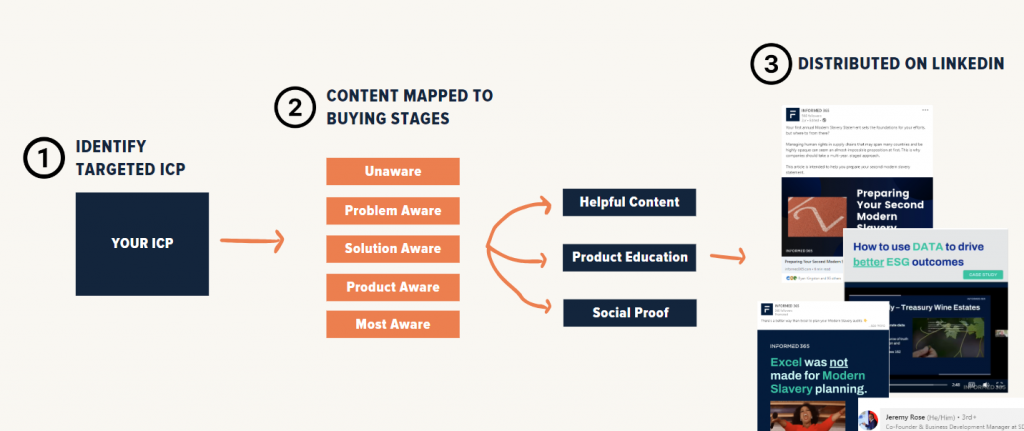
We also encourage marketers at Stage 3 to accelerate demand by testing a pilot Account Based Marketing program. Account Based Marketing (ABM) is where you select a handful of accounts based on your ICP, and create custom content, experiences, and work in tandem with sales to win them over as clients. An important note here is that you should select accounts to target that are already somewhat engaged with your brand – this is not to be used to win over a ‘wish list’ of logos.
Even if your sell a product with a low ARR that doesn’t justify the time spent on wining over each account, the mindset of tailoring your marketing and experiences to a segment can still make your marketing far more effective.
Kevin and I ran a mini-ABM series on The B2B Playbook. Catch our introductory episode here.
The complete list of steps in stage 3 are:
- Use paid media to target buying committee of key accounts
- Push educational content mapped to 5 Stages of Awareness
- Push product education content highlighting key benefits and features
- Focus on target accounts with low budget, high touch Account Based Marketing (ABM) pilot program
Again, we have covered each of these components in season 3 of The B2B Playbook (the season is called ‘BE Better’).
Stage 4 – BE Better – Optimise Your Workflow
Stages 1-3 are the fundamentals that every business needs to have in place and regularly revisit. They’re the biggest levers you can pull to drive growth. In stage 4, called ‘BE Better’, it’s all about how to now start incrementally improving your processes and optimisations.
This is where we recommend you focus your energy on things like:
- CRO and A/B testing
- Leveraging partners and affiliates
- Getting the most out of CRMs, CDPs and your Data
- Email marketing
- Expanding to new channels
- Integrating A.I into your processes
- Using the power of story telling to get closer to your customers
- Outbound marketing
- Social selling
- Community
- Customer Advisory Boards (CABs)
- Advanced reporting
- Event-led growth
The order in which you approach these is not as strict as in stages 1-3. We recommend you review which of these makes the most sense for your business, and the talent you currently have to execute these.
Stage 5 – BE The Best – Advanced Tactics for Demand Generation
Now you’re at the final stage of our Demand Generation marketing framework – Be The Best! This is where we break down tactics that are normally left for ‘the big guys’, and show B2B teams how they can implement them even with limited resources.
The elements and tactics we recommend you cover in stage 5 are:
- Future proofing your B2B marketing
- How to make people pay attention by thinking outside the box
- Building an education ecosystem
- Using neuroscience to get customers to say ‘yes’ more often
- Scaling strategies for small teams
- Crafting the perfect ‘offer’
- Bottom of funnel content that converts
Again, how you prioritise these is up to your business and what is most needed at that point in time.
Who is This Framework Designed For?
This framework is designed for B2B organisations that want their marketing team to start contributing real pipeline to their business. It’s for those that understand that there are no hacks, and no silver bullets to creating and executing a long term marketing strategy that helps a business close demand now, and win business in the future.
The materials that we provide you are typically designed specifically for smaller marketing teams (often 5 or less), but much larger teams have used them to drive growth for their businesses too.
Why Is The Framework Bullet Proof?
We have success stories across many industries, all across the world from people executing our 5 BEs Framework – whether they’ve learned it via our podcast, or joined our program The B2B Incubator to build their demand gen engines in 12 weeks.
It’s built around fundamental marketing principles that have worked for hundreds of years – just adapted to the B2B context.
The reason for that is that the strategy is not built around tactics that work ‘in the moment’ or are a flash in the pan success. It’s built around fundamental marketing principles that have worked for hundreds of years – just adapted to the B2B context.
At the end of the day, B2B marketing is about building relationships and trust between humans. Only once someone trusts you will they risk purchasing your product or service. Our 5 BEs Framework has this principle at its core, which is why it will continue to work well into the future.
The Fast Way To Implement This Demand Gen Strategy
The best time to have started a demand generation strategy is 6 months ago. But the second best time is today.
You could try and piece all of this together yourself, but that’s going to cost you a lot of time and resources that we know you probably don’t have.
If you want to implement this strategy the ‘fast’ way and the ‘right’ way in your business, we have a 12 week program called The B2B Incubator. When you join, you will build, document and execute your Demand Generation strategy in a small cohort of likeminded marketers.
We give you:
- The strategy
- The templates
- The tools to execute
- Live Q&As with me to ensure proper implementation
It’s a toolkit that you can take with you and use EVERY TIME you go-to-market.
Learn more about the program, why B2B marketers like you love it and how to join here.
Create Your Demand Engine in 12 Weeks
B2B marketing strategy that shows you step-by-step how to drive revenue
